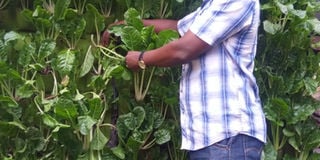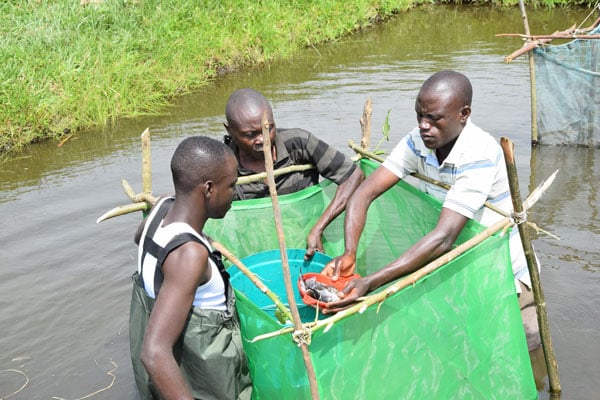Prime
Scarce rains: Farming techniques to adopt

You can grow a variety of crops vertically . Photo/file
What you need to know:
- From zai pits to farm ponds and vertical gardens, there are a number of climate-smart techniques you should embrace to continue producing food amid frequent dry spells.
As rains become scarcer and the temperature rises considerably due to the negative effects of climate change, most areas across the country are becoming drylands, making farming even harder.
Therefore, this calls for farmers particularly in areas that initially received constant rainfall to arm themselves with dryland farming technologies for continued food production.
Luckily, some of these technologies have been in use by farmers in arid and semi-arid areas for some years Seeds of Gold visited farmer Andrew in Nakasongola for lessons on farming amid scarce rains.
Nakasongola, is known for frequent droughts but Andrew, 37, who runs a model farm in the area, rarely feels the pinch.
On his three-quarter farm, he uses various technologies to successfully grow fruits such as pawpaws, oranges, watermelons, maize, tomatoes, collard greens, and traditional vegetables. The regenerative technologies he uses are:
Vertical gardens
Andrew’s vertical gardens are made of used tyres and dam liners, where he grows a variety of vegetables. With four floors, the first measuring 6ft long holds collard greens (sukuma wiki), the second is 4ft and hosts spinach while traditional vegetables such as amaranth sit on the third (3ft) and fourth (2ft).
The soil in the garden is mixed thoroughly with animal and plant manure before the crops are grown.
“With the garden partitioned using dam liners upwards, I grow up to five types of vegetables,” he tells Seeds of Gold.
According to him, the method of farming is efficient as it saves on space and water. “It is also easier to manage pests and diseases using vertical gardens, with multiple crops grown in one place.”
Rainwater harvesting
The farmer has dug three
farm ponds, all which collect rainwater. One harvests runoff water and the rest water from the roof catchment. The runoff pond measures 15m in length, 14m in width and has a depth 4m.
On the sides and bottom of the pond he has placed dam liners, and on the surface shade nets to prevent evaporation.
The second pond taps water from an eight by 15m greenhouse in which he grows tomatoes. It measures 20m in length, width 7m and height 3.5m and it took him 14 days to construct.
The smallest pond is 3 by 3m, and has a depth of 1.5m and it harvests water from the roof of his house. These ponds ensure that he has water to irrigate his crops all year round.
From the ponds, he pumps water into two tanks using a solar system, which then reaches his crops using drip lines and pipes for irrigation.
“The ponds collect 500,000 litres of water at full capacity. This enables me to farm the whole year without any hitches. I use about 1,000 litres of water daily,” he says.
Nursery trays
Most farmers plant directly maize seeds inside the holes in the field and wait for them to germinate before weeding. Well, while this is the traditional practice, you can raise the seeds on nursery beds first before transplanting them.
This is the method Andrew uses and it has paid dividends. He has 50 trays, where he raises the seedlings for three to four weeks before the onset of rains.
The seeds in the trays are planted on soil mixed with manure.
“With the technology, one is assured of almost 100 percent seed germination rate. The seeds are well-taken care of under an open shade net for good growth. The method saves time and reduces losses in case of rain delay or failure,” explains Pius Opiyo, an agronomist from Ace Africa, an NGO, noting the crop can also be planted and grown under irrigation.
Other technologies on Andrew’s farm are intercropping of vegetables, soya beans, and maize with fruit trees such as pawpaws.
The farmer is also practising agroforestry, where he grows trees which are vital in fixing nitrogen in the soils and leucaena mainly for animal feed formulation and supplementing.
Zai pits
Andrew plants his crops in zai pits. The innovation, also known as planting pits, is water-efficient and is popular mainly in arid and semi-arid areas.
In the open field, he has prepared 2 by 2 by 2 feet holes. A farmer can also make circular or semi-circular pits.
For maize, with holes spaced a metre apart, one ends up with about 400 zai pits on an acre. Well-decomposed manure – from compost and livestock – is mixed with top soil. In one hole one plants five seedlings of maize.
Besides maize, Andrew uses the method to grow vegetables and beans. Drip lines run inside the pits supplying water. He notes zai pits are a climate-smart technology that boost production especially in areas experiencing low rainfall and prolonged drought.
“Climate change is a reality, and we have to transform farming by embracing technologies to mitigate the effects,” he says.





